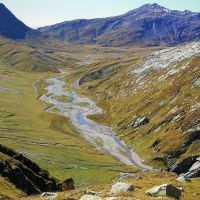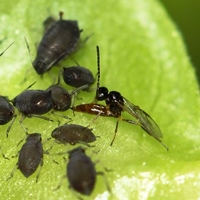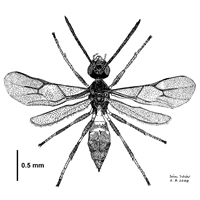
It has become increasingly clear that numerous insects rely on heritable bacterial endosymbionts for protection against parasitoids. Although a large body of laboratory work is consistent with such defensive symbionts having a pervasive influence on host-parasitoid interactions, a realistic appreciation of their relevance has to come from field studies. This project is a rigorous attempt to investigate the ecological and evolutionary role of defensive symbionts in natural aphid-parasitoid communities.

Increasing water temperatures and altered hydrological regimes due to climate change increasingly impact freshwater habitats, which are also subject to other man-made stressors such as structural degradation and pollution. The joint effects of multiple stressors on freshwater biodiversity are difficult to predict because of interactions among stressors and because of species interactions in aquatic food webs. Their understanding is crucial, though, for evidence-based conservation of freshwater biodiversity, and for the use of biodiversity-based indicators in environmental impact assessment. With the support of the Swiss Federal Office for the Environment (FOEN), the main funder of this research program, we address this challenge using models and experimental approaches. Link to research program.

Antagonistic coevolution between hosts and parasites may be the driving force behind many important evolutionary phenomena, including the maintenance of genetic polymorphism. Coevolution between aphid hosts and their hymenopteran parasitoids is strongly influenced by facultative endosymbiotic bacteria that increase host resistance. This challenges existing models of host-parasite coevolution by adding another layer of complexity. We develop models describing the expected dynamics of such symbiont-mediated coevolution and we study this process empirically from the level of individual genotypes up to the level of the biological community, using the black bean aphid, Aphis fabae, and its parasitoid Lysiphlebus fabarum as a study system.
Together with climate change, biodiversity decline is the most pressing environmental crisis the world is facing. One factor hampering our society’s ability to stop and reverse the loss of biodiversity is insufficient exchange of knowledge and information between science and practice, called the science-practice gap. Bridging this gap is the purpose of the “Translational Centre Biodiversity Conservation” (TCBC), a Joint Initiative funded by the ETH Board within the Strategic Area “Engagement and Dialogue with Society”. It is developed by three ETH Domain institutions (WSL, Eawag, ETH Zürich) with partners from cantonal authorities, private consultancies and environmental organisations. Our goal is to provide conservation professionals with synthesized information on topics relevant to their daily work.

The evolutionary maintenance of sex remains one of the big unresolved questions in biology. A promising system to study this question empirically are aphid parasitoids of the genus Lysiphlebus. They comprise sexual (arrhenotokous) and asexual (thelytokous) lineages, and asexual reproduction is unconfounded with hybridisation, polyploidy or the possession of parthenogenesis-inducing microbes. Crossing experiments demonstrated that thelytoky has a simple genetic basis and is inherited as a single-locus recessive trait, but the responsible genes are still unknown.

Native freshwater crayfish in Europe are endangered due to habitat degradation, competition by introduced crayfish species, and a deadly disease (crayfish plague) vectored by these introduced species. Remaining populations of native crayfish are largely restricted to small and disconnected tributaries. The massive fragmentation of streams and rivers by man-made barriers prevents genetic exchange between them as well as the recolonization of streams after local extinctions. We use population genetic methods to study the genetic structure and diversity of the remnant populations of stone crayfish (Austropotamobius torrentium) and white-clawed crayfish (A. pallipes), with the aim of aiding and informing conservation measures for these endangered species.
